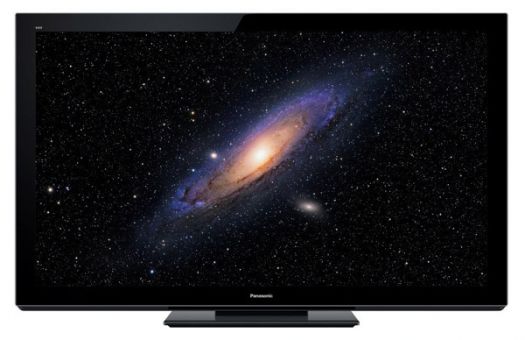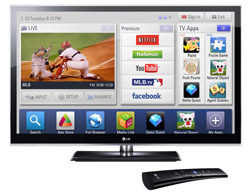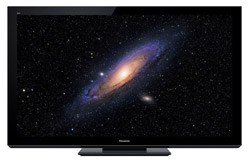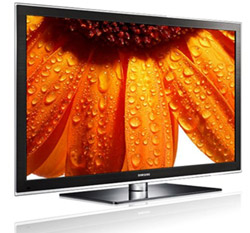Plasma TV has been around for quite some time now. Back in the late '90s, it was considered something strictly for the lifestyles of the rich and/or famous -- but mostly the rich. How rich? $14,999 for a 42-inch Philips plasma TV - and it wasn't even high definition! Thanks to advancements in the technology, plasma has really come down in price (by an order of magnitude) over the years.
In the past year alone, plasma has really gone from "must-have" to "do have." According to a recent study by Display Research, 2010 was a very good year for plasma manufacturers. Plasma shipments actually grew a total of 9 percent Y/Y, which translates to a total of 19.1 million units shipped in 2010.
That may not seem like a huge number, but it certainly does to plasma manufacturers -- all three of them. LG, Panasonic and Samsung have had a pretty tight hold on the plasma market, and still do today.
Why more manufacturers aren't in the plasma game has something to do with how its made. Frankly, it's not cheap to build a plant. It's also, well... not cheap. Plasma TVs use reflective glass and a mixture of gasses to make those big, beautiful HD images. Also, plasma pixels are self-emissive (self-illuminating), which means that plasma TVs don't need backlighting. And this fundamental difference between plasma and LEd/LCD sets is what allows plasma TVs to produce superior black levels (contrast) and richly saturated colors. However, that's not the only thing that sets plasma apart from other TV technologies out there.

What to Expect from the Tech
Today's plasma TVs have come a long way. In the early years, plasmas were plagued with the problem of burn-in. Advances in phosphor technology and other preventive measures have all but eliminated those issues. Occasionally, a station logo or videogame on-screen health monitor may linger on screen after hours of continued use. Don't panic, though; those logos quickly fade, making the risk of permanent burn-in damage an issue of the past.
When looking at plasma specs (you do that, right?), you may notice that these sets don't normally use any type of motion processing. LCD and LEDs quote a refresh rate (e.g., 120 Hz, 240 Hz), which helps those sets keep up with moving images without any on-screen blurring. Because of how fast the phosphors in a plasma TV fire (and decay), plasmas don't need this kind of processing, although you may occasionally see them listed with a "sub-field drive." This spec (currently 600 Hz on most plasma TVs) is just to let you know that plasma pixels pulse 10 times per full screen refresh as they build the full image. Plasma TV's handling of moving images is another differentiating factor that makes them an excellent choice for sports, action flicks, and other fast-moving content.
Size Matters!
Good luck finding a tiny plasma TV for your bedroom or kitchen. Plasma TVs are typically big -- the smallest available in the US is now 42 inches -- and these could be overpowering in those areas. Don't just say, "yeah, yeah." There's actually some science behind screen versus room size, which means that a plasma TV probably isn't the best choice for those smaller spaces.
Besides making it big, plasma TV actually looks good -- and from almost any angle. Their wide field of view means it's easy to position a plasma TV in any room, without having to build seating around the center point of the TV. Just keep it away from the windows, or at least direct sunlight. Screen coating advancements have made ambient room light less of an issue with plasma, but it's still there. If you have a super-sunny room, think about buying an LCD or LED instead (but make sure it doesn't have one of the newer reflective screens that are becoming popular on high-end LED TV models).
Also keep in mind: Even though plasma has advanced over the years, there's still a lot of misinformation out there. First up, plasmas do NOT leak gas. They never have and never will. Also, today's plasmas are built to last. While that new plasma purchase may not be a family heirloom, you'd have to watch TV six hours a day for 45 years before the average plasma TV reaches half brightness. If you watch more TV than that, you might want to think about getting out more.
If six hours a day (or less) sounds about right, you may be in the market for a new plasma TV. Let's take a peek at what each of the three plasma manufacturers are offering in this category for 2011.
LG

For a full HD image, the PV450 Series offers 1080p in two Tru-Slim sizes. Other features include a 3,000,000:1 contrast ratio, three HDMI inputs, one USB port, and Intelligent Sensor to tweak the image based on the room's lighting conditions.
If you're looking for a little 3D, the PW350 Series has it, along with a 720p resolution (actually 1024x768 on the 42-inch model and 1366x768 on the 50-incher). Available in two screen sizes, this line includes LG's TruSlim frame, 2D-to-3D conversion, the 600Hz refresh rate, a 10,000,000:1 rated contrast ratio, and the Intelligent Sensor feature.
One other TruSlim line is the PZ550 Series. This line bumps up the two screen sizes as well as the image, to full 1080p HD. Besides the features mentioned above, both of these TVs also offer DLNA support and NetCast, which provides instant, on-screen access to Netflix, CinemaNow, Yahoo Widgets, Pandora and VUDU. If you want to make the whole setup wireless, add in LG's AN-WF100 Wi-Fi USB Adapter.
The PZ750 Series takes both the image and the entertainment to the next level. First, both of these sets have THX 3D certification. This series also adds a little Smart TV into your viewing experience. This is LG's newest web platform, which features additional content and the Magic Motion Remote. That remote allows you to use motion to flip through services, videos, news, photos, and other content options.
The last of LG's 3D plasma offerings for 2011 lies in the PZ950 Series. Both models feature all of the PZ750's features, as well as TruBlack Filter, which boasts a better image by eliminating glare and accentuating black levels.
Panasonic

If one of those USB ports just happens to be free, consider adding the DY-WL10 Wi-Fi adapter, which adds in wireless connectivity. That connection makes Panasonic's EASY IPTV easy to access. EASY IPTV is an instant, on-screen service that includes Netflix, Pandora, Napster, Facebook, Amazon Instant Video, and CinemaNow. Also, because these are VIERA sets, each one has VIERA Image Viewer and VIERA Tools features.
For 1080p images, Panasonic has the S30 Series. All four S30 models have all of the same perks that are listed above, but add in the full 1080p HD image. Other features include Deep Color and x.v.Color support, a Game Mode, three HDMI inputs, and VIERA Link, which gets all of your compatible AV devices under one remote.
If you want to take your home theater into the third dimension, Panasonic is offering 12 different screen sizes across three lines. The first up is the ST30 Series, which has a total of six 1080p 3D TVs. All have the Infinite Black 2 Panel and fast switching phosphors, as well as all of the VIERA features listed above, the 600Hz Sub-field Drive, DLNA support, three HDMI connections and two USB ports.
All six models also have Panasonic's own VIERA Connect service, which provides everything in EASY IPTV and more: instant, on-screen access to Netflix, Amazon VOD, YouTube, Pandora, Twitter, Napster, Hulu Plus, Facebook, and much more. All of Panasonic's 2011 3D-ready full HD TV models include the DY-WL10 Wireless LAN Adapter. If you're looking for a nice add-on though, try the Freetalk Conference HD Camera, which enables Skype video calling from any of these 3D TVs.
All of the same features mentioned above can be found in the VIERA GT30 Series. However, these four models add in THX certification and boast picture quality enhancements for enhanced black levels and contrast. Other features include automatic grey scale calibration with SpectraCal's CalMAN software, four HDMI inputs and three USB ports.
Panasonic has two top-of-the-line TVs in its VT30 Series. Besides everything mentioned above, each VT30 3D TV features a one sheet glass design and an Infinite Black Pro 2 panel with a special glass treatment that further accentuates the panel's black level performance. Remember the old Pioneer KURO plasmas? Legendary for their super-low black levels? Well many of those engineers went to work for Panasonic after Pioneer got out of the TV business, so expect to see some really outstanding images on the VT30 series. All that extra attention promises more subtle, delicate blacks, in both dark and bright environments. Another nifty perk is that each set comes with one pair of active 3D glasses, for 3D viewing right out of the box.
Samsung

Despite being an "entry-level" plasma, the D450 Series does feature the Plasma+1 premium. This new design offers an extra inch of viewing screen without increasing the outside dimensions. Other features on both 2D HDTV models includes 600Hz Subfield Motion, two HDMI ports, and ConnectShare JPEG so you can access music and photos from a connected USB drive.
The D490 Series adds 3D features to the list mentioned above, as well as an extra HDMI input (for three total). ConnectShare Movie adds video to the digital mix that can be accessed on an external USB drive. Both models also have a built-in swivel stand, which allows you to twist and turn the TV up to 10 degrees left or right.
The three models in the D550 Series receive a nice bump, via a full 1080p HD image. Other features include Samsung's own Crystal Full HD Engine, AllShare DLNA support, two HDMI inputs, and two USB ports.
The D6500 Series is where Samsung's 2011 plasma start to smarten up. Besides the above features, each of these sets feature Samsung Smart TV, which allows viewers to search for movies and TV shows, explore Samsung apps, chat and access other interactive TV content. You can also expect Netflix, Hulu Plus, YouTube, ESPN, Pandora, and other familiar services. Connecting to all of that content is also extremely easy, since each set has built-in Wi-Fi support.
Other features include Samsung's own Touch of Color black bezel, four HDMI inputs, and two USB ports.
All three models in the D7000 Plasma Series have Smart TV access and built-in Wi-Fi. Two unique features are the company's signature brushed metal bezel design as well as Real Black Panel, which promises to cut the glare and boost the on-screen image's contrast ratio.
Finally, the three models in Samsung's D8000 Plasma Series come with the Quad Stand, which is slightly slimmer this year. Other features include Local Contrast Enhancer (LCE) and Cinema Black, which promise to boost black levels a little better than what's listed above.
More Buyers Guides:
Also Check Out: